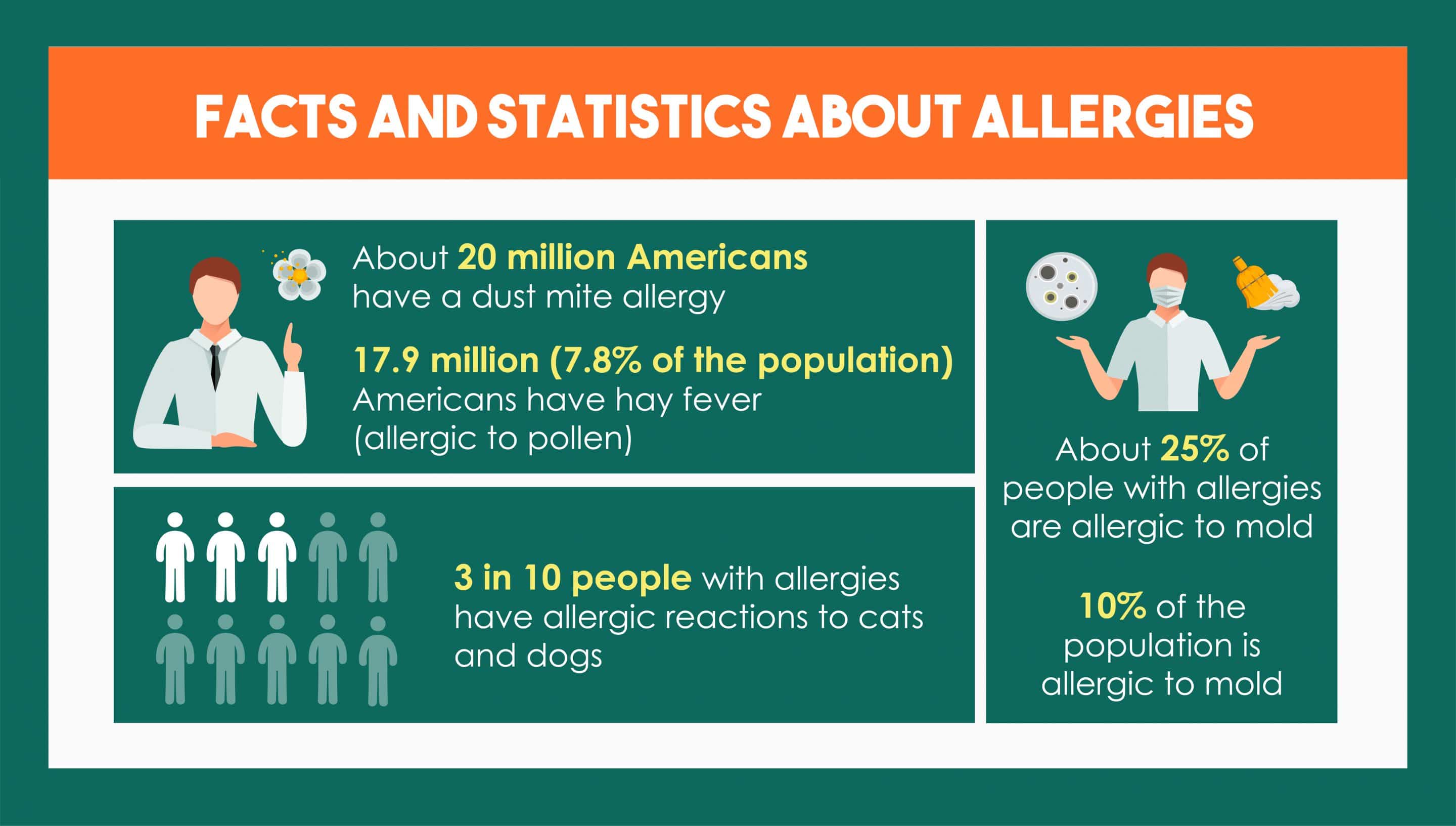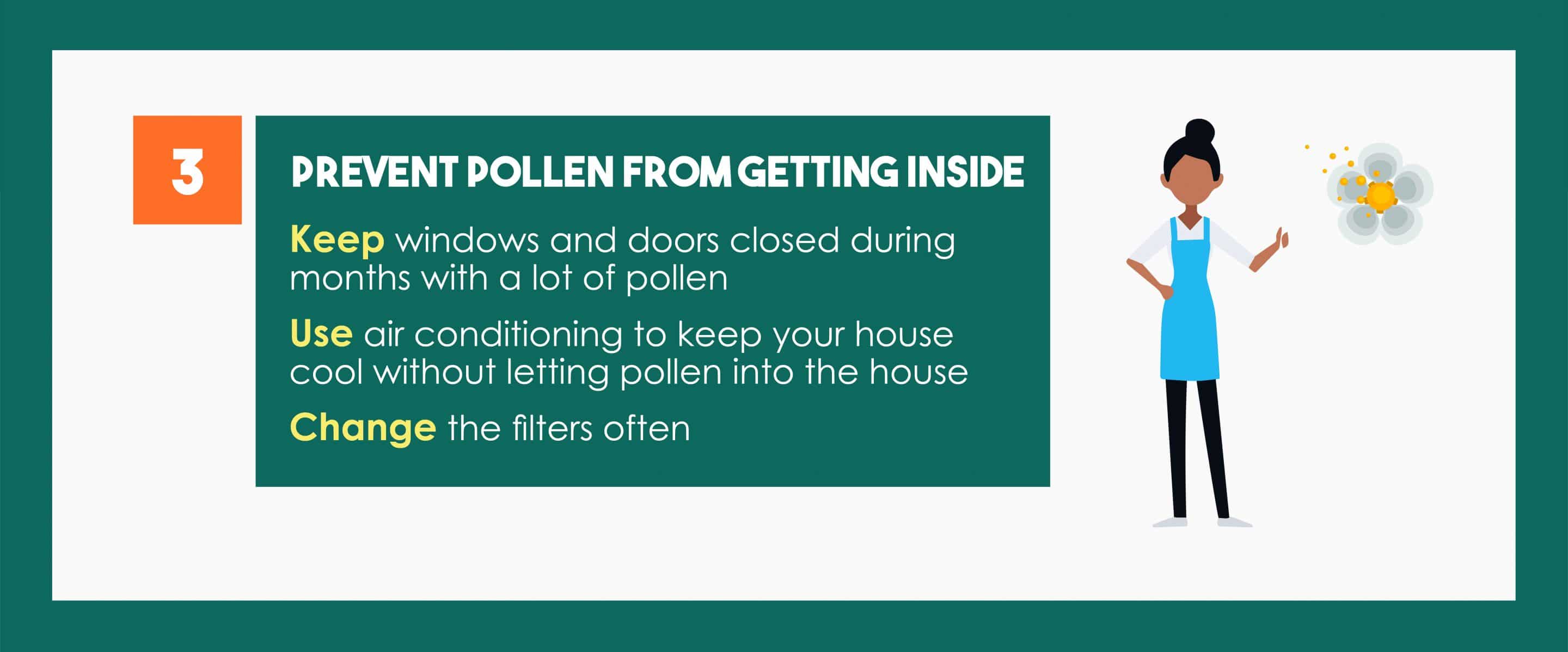There are a surprising amount of allergens in your home, and most people are shocked when they find out all the contributing factors that make allergens a serious issue.

As you can see you aren’t the only one with allergies and you could possibly be getting them in your home from pollen, pets, and mold.
Cleaning your house frequently and correctly is the key to reducing dust mites, mold, and most allergens. If your family suffers from specific allergies, these cleaning methods could help.
Too Many Dust Mites

Controlling dust mites in your home is the best way to get rid of unwanted allergens. Typically, dust mites are the culprit to allergies.
Here’s the good news:
Dust mites aren’t hard to get rid of, and you’ll notice a significant difference if you start implementing some of these cleaning tactics.
De-clutter your home—the less you have lying around, the fewer things there are for dust to settle on.
Properly clean the items in your home with a damp rag or a cloth that has furniture polish on it because a dry rag will only spread the dust around and put it into the air. Furthermore, it’s a good idea to wear a mask if you’re particularly susceptible to dust mites.
Avoid wall to wall carpet, especially shag carpet and try to have as much hardwood as possible and use area rugs where you’d like.
Wash your bedding at least once a week in hot water. Your bed linen is a breeding ground for dust mites, mainly because your bedroom is where you spend one-third of your time.
Not Enough Vacuuming

Carpets harness a lot of dust mites and other allergens, and you should try to vacuum your carpet and upholstered furniture at least once or twice a week to reduce the allergens.
Be careful:
Vacuuming can also put dust particles into the air and might exacerbate the problem. You should use a vacuum cleaner with a HEPA filter because it’s designed to trap very small particles. This prevents dust from going back into the air.
Too Much Pollen

Pollen is a common allergen that makes many people suffer in the Spring and Fall.
Don’t worry:
There are lots of ways to control the amount of pollen that enters your home so that you can get away from it.
Start by keeping your windows and doors closed. It’s a lot harder for pollen to get into your home if there’s no entry.
Use air conditioning to cool your house down instead of letting a breeze come through the house. It will significantly reduce the amount of pollen in your home.
Never let your clothes hang outside to dry if you’re susceptible to a pollen allergy. Washing your clothes and taking a shower after you’ve been outside will also help keep pollen at bay.
Don’t forget about your pet; they might be the culprit of bringing pollen into your home. Also, keep your pet’s fur short and bathe them frequently.
Too Much Pet Dander
If you want a pet but you suffer from allergies, get a pet that has fewer allergenic protein in their dander; which is a pet that doesn’t shed. However, all animals will shed a little.
Already have a cat or dog that sheds?
If so, bathe your pet at least once a week to reduce the dander and brush them regularly as well. Furthermore, don’t forget to wash any pet bedding in hot water too.
Are you still having allergy problems?
Consider making your bedroom or other parts of the house a pet-free zone. It will help create areas of the house that are free from pet dander and will give you some relief if you have severe allergies.
Too Much Moisture

Having too much moisture in areas of the house with lots of water causes mold and mildew growth—bathrooms and basements are some of the biggest culprits.
Replace wallpaper in the bathroom with tile or mold-resistant paint because wallpaper retains moisture and becomes a breeding ground for mold.
Wipe down walls and the bathtub after you’re done taking a shower. It’s also a good idea to turn on your exhaust fan to get rid of some of the moisture while you’re showering.
Here’s the most shocking part:
Too many indoor plants can create more allergens in your home. Although house plants have been known to help purify the air, too many will increase the humidity in your home—which encourages mold and mildew growth. Limit yourself to just a couple of indoor plants.
Over-Cleaning the Carpet To Remove Allergens
Shampooing the carpet gets rid of dirt and dust mites right?
Not always.
In fact, the leftover moisture from shampooing carpets could result in mold growth or an increase in dust mites.
Shampoo your carpet if you absolutely need to, but don’t be excessive. Better yet, replace your carpet with hardwood flooring, and you won’t need to worry about it at all!
The Bottom Line About Allergens
You don’t have to deal with allergies in your own home because there are several ways to fix the problem with just a few changes.
Make a chart of weekly chores to help control the allergens in your home and prevent them from getting worse and prioritize each task and make sure you get them done.
These cleaning tactics will make a significant difference, and you’ll be able to relax, enjoy, and breathe easily in your allergen-free home.
The Shocking Reasons Why Your Home is an Allergen Breeding Ground

Share this Image On Your Site
<p><strong>Please include attribution to https://pickvacuumcleaner.com with this graphic.</strong><br /><br /><a href=’https://pickvacuumcleaner.com/home-an-allergen-breeding-ground/’><img src=’https://pickvacuumcleaner.com/app/uploads/2019/05/11-Tips-For-An-Allergy-Free-Home-Infographic-05-24-19.jpg’ alt=’11 Tips For An Allergy-Free Home’ width=’1500px’ border=’0′ /></a></p>

With a degree in engineering, Kathryn Hansen loves to write about how things work. Having her own dilemmas on how to pick the best vacuum cleaner for her large family (with a handful of furry four-legged members as well), Kathryn decided to help others in the same situation. After all, vacuum cleaners are critical to a healthy lifestyle and people have a hard time choosing the best one for their needs.
